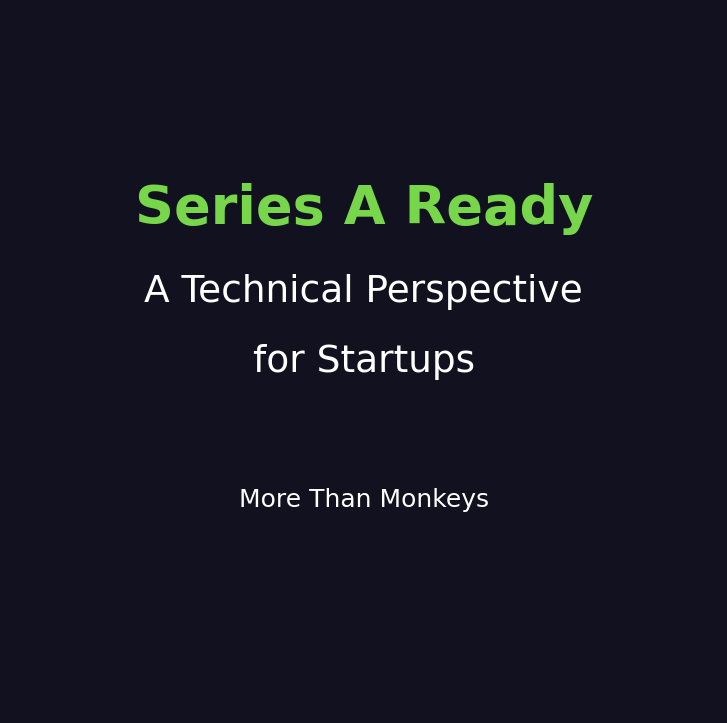How to Take Your Startup into Series A Funding: A Technical Perspective
by Gary Worthington, More Than Monkeys

Seed funding is about proving your idea. Series A is about proving your company can scale. At this stage, investors stop asking
“does this solve a problem?”
and start asking
“can this team build a scalable, defensible business?”
From a technical perspective, that means more than just a working product. It means architecture, processes, and practices that inspire confidence not only in your users, but in the investors doing due diligence.
Here’s what you need to get right.
1. From MVP to “Investable” Product
Your MVP got you early users and traction. But by Series A, the bar shifts:
- MVP focus: Does it work at all?
- Series A focus: Will it keep working when you have 10× the users, 10× the data, and a team that’s doubling in size?
Investors will look beyond the feature set to the resilience of your stack.
2. What Technical Due Diligence Looks Like
Every Series A investor runs some form of technical due diligence. It varies, but common questions include:
- Architecture: Can it scale horizontally? Are there obvious single points of failure?
- Codebase: Is it maintainable, or a tangle of technical debt?
- Security: Are data protection and access controls in place?
- Processes: How do you deploy? How do you test? What happens if something breaks?
- People: Does the team have the skills to execute the next phase?
The diligence isn’t about perfection. It’s about risk. Show you’ve thought about the right things, and you’ll pass. Hand-wave your way through, and it can kill the round.
3. The Engineering Maturity Curve
At seed, you can get away with cutting corners. At Series A, you need to climb a maturity curve.
Key shifts:
- Testing: Move from manual checks to automated tests and CI/CD.
- Infrastructure: From a single region deployment to multi-AZ, maybe multi-region.
- Monitoring: From CloudWatch logs nobody reads to real dashboards and alerts.
- Security: From “password in .env file” to secrets management, MFA, and least privilege IAM.
- Process: From “push to main and hope” to peer review, branching, and predictable releases.
You don’t need enterprise-grade process, but you do need to show intent and progress.
4. Proving Scalability
Investors want confidence that your product can handle growth. That doesn’t mean building for millions of users prematurely, but it does mean:
- Load testing your APIs and documenting results.
- Automated scaling rules in your cloud provider.
- Database planning: knowing when to shard, partition, or switch engines.
- Bottleneck awareness: can you explain what will break first, and how you’ll fix it?
A simple Locust or k6 load test can go a long way in demonstrating you’ve thought about scale.
5. Security and Compliance Basics
Even if you’re not yet pursuing enterprise customers, investors expect you to avoid obvious risks. At minimum:
- Encrypt data at rest and in transit.
- MFA for admin accounts.
- Role-based access control.
- Dependency scanning and patching.
- A clear approach to GDPR and data deletion.
You don’t need ISO 27001 certification yet, but you do need to show a responsible attitude to security.
6. Building a Team That Can Scale
Series A funding usually means growing the team. Investors will look at your hiring plan, but they’ll also look at your technical leadership.
Ask yourself:
- Is your codebase ready for new engineers to onboard quickly?
- Do you have coding standards and a review culture?
- Is knowledge siloed in one founder’s head, or spread across the team?
- Can you delegate, or are you the bottleneck?
A well-prepared engineering team is as reassuring as the tech itself.
7. Documentation and Transparency
Documentation sounds boring, but it’s a trust signal:
- Architecture diagrams show how the system works.
- Runbooks explain how to handle incidents.
- Onboarding docs get new hires productive faster.
- Security policies show you take compliance seriously.
Investors don’t expect reams of paperwork, but they do expect to see evidence of discipline.
8. Balancing Speed with Readiness
The biggest fear for founders is that Series A prep will slow them down. The trick is prioritisation.
- Must-have: CI/CD, monitoring, basic security, load testing.
- Nice-to-have: full compliance certification, 24/7 support, enterprise integrations.
Focus on the former. They prove you can scale responsibly without drowning in process.
9. Why It Matters
Series A is a credibility test. Investors want confidence that their money won’t vanish into rewrites, outages, or security breaches. By showing technical readiness, you de-risk the deal.
It’s not about being perfect. It’s about showing you know where the risks are, and that you have a plan to handle them.
Conclusion
Series A funding isn’t won on technology alone. But weak technology can lose it.
The startups that succeed show a balance: fast enough to innovate, disciplined enough to inspire trust. By investing in scalable architecture, basic security, monitoring, and process, you not only make your product better, you make your company investable.
At More Than Monkeys, we help startups reach that point. From MVPs through to Series A and beyond, we’ve seen how the right technical foundations make the difference between deals that close and deals that stall.
Gary Worthington is a software engineer, delivery consultant, and agile coach who helps teams move fast, learn faster, and scale when it matters. He writes about modern engineering, product thinking, and helping teams ship things that matter.
Through his consultancy, More Than Monkeys, Gary helps startups and scaleups improve how they build software — from tech strategy and agile delivery to product validation and team development.
Visit morethanmonkeys.co.uk to learn how we can help you build better, faster.
Follow Gary on LinkedIn for practical insights into engineering leadership, agile delivery, and team performance.